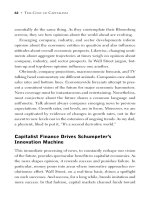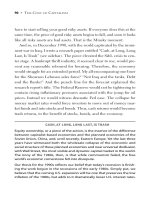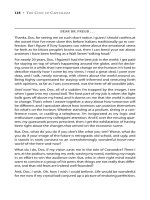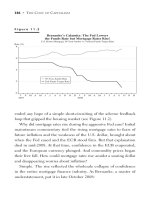Lecture Managerial finance - Chapter 10: The cost of capital
Bạn đang xem bản rút gọn của tài liệu. Xem và tải ngay bản đầy đủ của tài liệu tại đây (528.84 KB, 39 trang )
CHAPTER 10
The Cost of Capital
1
Topics in Chapter
Cost of Capital Components
Debt
Preferred
Common Equity
WACC
2
What types of longterm
capital do firms use?
Longterm debt
Preferred stock
Common equity
3
Capital Components
Capital components are sources of funding
that come from investors.
Accounts payable, accruals, and deferred
taxes are not sources of funding that come
from investors, so they are not included in the
calculation of the cost of capital.
We do adjust for these items when calculating
the cash flows of a project, but not when
calculating the cost of capital.
4
Beforetax vs. Aftertax
Capital Costs
Tax effects associated with financing
can be incorporated either in capital
budgeting cash flows or in cost of
capital.
Most firms incorporate tax effects in the
cost of capital. Therefore, focus on
aftertax costs.
Only cost of debt is affected.
5
Historical (Embedded) Costs
vs. New (Marginal) Costs
The cost of capital is used primarily to
make decisions which involve raising
and investing new capital. So, we
should focus on marginal costs.
6
Cost of Debt
Method 1: Ask an investment banker
what the coupon rate would be on new
debt.
Method 2: Find the bond rating for the
company and use the yield on other
bonds with a similar rating.
Method 3: Find the yield on the
company’s debt, if it has any.
7
A 15year, 12% semiannual bond
sells for $1,153.72. What’s rd?
0
1
i=?
60
60
30
N
OUTPUT
30
...
-1,153.72
INPUTS
2
-1153.72 60
I/YR
PV
PMT
60 + 1,000
1000
FV
5.0% x 2 = rd = 10%
8
Component Cost of Debt
Interest is tax deductible, so the after
tax (AT) cost of debt is:
rd AT = rd BT(1 T)
rd AT = 10%(1 0.40) = 6%.
Use nominal rate.
Flotation costs small, so ignore.
9
Cost of preferred stock: PP =
$113.10; 10%Q; Par = $100; F = $2.
Use this formula:
rps =
Dps
0.1($100)
=
Pps (1-F)
=
$116.95(1-0.05)
$10
= 0.090=9.0
$111.10
%
10
Time Line of Preferred
0
rps=?
1
...
2.50
-111.1
$111.10=
rPer =
2
$2.50
2.50
DQ
rPer
∞
2.50
= $2.50
rPer
= 2.25%; rps(Nom) = 2.25%(4) = 9%
$111.10
11
Note:
Flotation costs for preferred are
significant, so are reflected. Use net
price.
Preferred dividends are not deductible,
so no tax adjustment. Just rps.
Nominal rps is used.
12
Is preferred stock more or less
risky to investors than debt?
More risky; company not required to pay
preferred dividend.
However, firms want to pay preferred
dividend. Otherwise, (1) cannot pay
common dividend, (2) difficult to raise
additional funds, and (3) preferred
stockholders may gain control of firm.
13
Why is yield on preferred
lower than rd?
Corporations own most preferred stock,
because 70% of preferred dividends are
nontaxable to corporations.
Therefore, preferred often has a lower
BT yield than the BT yield on debt.
The AT yield to investors and AT cost to the
issuer are higher on preferred than on debt,
which is consistent with the higher risk of
preferred.
14
Example:
rps = 9%
rd = 10%
T = 40%
rps, AT = rps - rps (1 - 0.7)(T)
= 9% - 9%(0.3)(0.4)
= 7.92%
rd, AT = 10% - 10%(0.4)
= 6.00%
A-T Risk Premium on Preferred = 1.92%
15
What are the two ways that
companies can raise common
equity?
Directly, by issuing new shares of
common stock.
Indirectly, by reinvesting earnings that
are not paid out as dividends (i.e.,
retaining earnings).
16
Why is there a cost for
reinvested earnings?
Earnings can be reinvested or paid out
as dividends.
Investors could buy other securities,
earn a return.
Thus, there is an opportunity cost if
earnings are reinvested.
17
Cost for Reinvested Earnings
(Continued)
Opportunity cost: The return
stockholders could earn on alternative
investments of equal risk.
They could buy similar stocks and earn
rs, or company could repurchase its own
stock and earn rs. So, rs, is the cost of
reinvested earnings and it is the cost of
equity.
18
Three ways to determine
the cost of equity, rs:
DCF: rs = D1/P0 + g.
19
DCF Cost of Equity, rs: D0 =
$4.19; P0 = $50; g = 5%.
rs =
D1
P0
+g=
D0(1+g)
P0
+g
= $4.19(1.05) + 0.05
$50
= 0.088 + 0.05
= 13.8%
20
Could DCF methodology be
applied if g is not constant?
YES, nonconstant g stocks are
expected to have constant g at some
point, generally in 5 to 10 years.
But calculations get complicated. See
the “Web 10B” worksheet in the file
“FM12 Ch 10 Tool Kit.xls”.
21
Determining the Weights for
the WACC
The weights are the percentages of the
firm that will be financed by each
component.
If possible, always use the target
weights for the percentages of the firm
that will be financed with the various
types of capital.
22
Estimating Weights for the
Capital Structure
If you don’t know the targets, it is better
to estimate the weights using current
market values than current book values.
If you don’t know the market value of
debt, then it is usually reasonable to use
the book values of debt, especially if the
debt is shortterm.
23
(More...)
Estimating Weights
(Continued)
Suppose the stock price is $50, there
are 3 million shares of stock, the firm
has $25 million of preferred stock, and
$75 million of debt.
(More...)
24
Estimating Weights
(Continued)
Vce = $50 (3 million) = $150 million.
Vps = $25 million.
Vd = $75 million.
Total value = $150 + $25 + $75 = $250
million.
25









